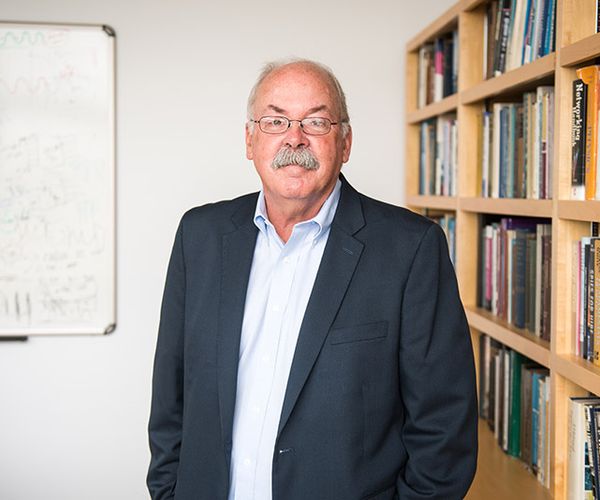David Bishop (ECE, Physics, MSE, ME, BME) was awarded the 2026 Oliver E. Buckley Condensed Matter Physics Prize on November 5, 2025, for groundbreaking experiments that uncovered the role of vortices in the superfluid phase transition in helium films and observed anyonic braiding statistics of quasiparticles in the fractional quantum Hall effect, thus establishing the significance of topological excitations in two-dimensions.
The Buckley Prize recognizes outstanding theoretical or experimental contributions to condensed matter physics.
Bishop was recognized along with John D. Reppy, Gwendal Fève, and Michael James Manfra, who received his PhD in Physics at the College of Arts & Sciences in 1999.
In addition to serving as the head of the Division of Materials Science & Engineering, Bishop also has appointments in Electrical & Computer Engineering, Biomedical Engineering, and Physics in the College of Arts & Sciences. He is a Photonics Center faculty member, as well as the Engineering Director of the CELL-MET Engineering Research Center. Bishop is also a fellow in the National Academy of Inventors and the National Academy of Engineering.
“I am honored, humbled, a little shocked, and deeply appreciative of this award,” said Bishop. “It is astonishing that John Reppy (my thesis advisor) and I have won this now as this research was my thesis fifty years ago. As more modern work was added to our understanding of superfluids and 2D systems, I assumed that any such recognition was not in the cards.”
What are superfluids?
All normal liquids have a viscosity. That viscosity can be large, like cold maple syrup, or small like water, but all conventional liquids have a non-zero viscosity. However, superfluids have zero viscosity. They are the fluid analogs of superconductors, which, unlike normal metals, can have zero resistance at low temperatures.
Reppy and Bishop studied a 2D version of superfluidity in He4, with films only an atomic layer or two thick. A normal liquid that thin could not flow; its viscosity would lock it to the substrate. However, 2D superfluids, because they have zero viscosity, can flow. Reppy and Bishop built a very sensitive microbalance to study the flow of these atomically thin superfluid He4 films. What they observed puzzled them at first. The superfluid density, a measure of the fraction of superfluid within the entire liquid, did not go continuously from a finite value to zero at the transition temperature, the way it did for 3D systems. Instead, in these 2D systems, it dropped precipitously from a finite value to zero at the transition.
A foundation of scholarship
Other scientists built upon Bishop and Reppy’s work. David Nelson at Harvard University suggested the results might be explained by the Kosterlitz Thouless (KT) theory. Nelson, and his collaborators, Vinay Ambegaokar (Cornell University), Bert Halperin (Harvard University), and Eric Siggia (Rockefeller University) reworked the theory into a form applicable to Bishop and Reppy’s system, and the agreement with that theory was astonishingly good.
While Reppy and Bishop had not set out to verify the KT theory, that was precisely what they ended up doing.
In the intervening years, understanding of the strange behavior of 2D quantum systems has exploded. Today, in systems like 2D electron gases, graphene, and many others, the ideas of KT are having a tremendous impact on our understanding of 2D quantum systems. In 2016, David Thouless, Duncan Haldane, and J. Michael Kosterlitz were awarded the Nobel Prize in Physics. Bishop and Reppy’s work in 2D superfluid systems played a small, but nevertheless important role in providing early experimental support for those ideas.
A fruitful career
“My results at Cornell generated some buzz, and I was lucky enough to get a postdoc at Bell Labs. The two-year postdoctoral appointment turned into a 33-year career where I could work with, and learn from, some of the late 20th century’s most profound scientists and engineers. In 2011, I was also fortunate when Ken Lutchen hired me to lead the BU Division of Materials Science & Engineering. These years have been wonderful, giving me a chance to do research in a very different direction and help train the next generation.”
The Buckley Prize serves as a capstone to Bishop’s career. “I’ve been blessed by being able to work at Syracuse University, Cornell University, Bell Labs and now Boston University.”
“This recognition of David Bishop is a testament to David’s leading scholarship and ingenuity,” said Elise Morgan, Dean, College of Engineering and the Maysarah K. Sukkar Professor of Engineering Design and Innovation. “This prestigious prize marks just one example of his creativity, curiosity, and drive. We at BU have benefitted many times over from David’s contributions as a faculty member in the College of Engineering and as the Head of the Division of Materials Science & Engineering.”
